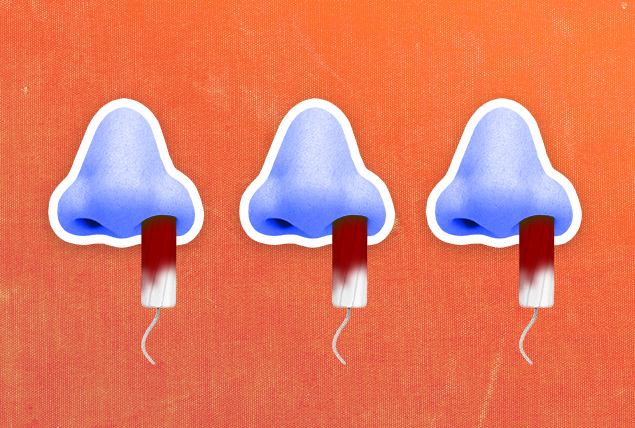Can Those Symptoms Be Allergies to Your Period?

Dana, a 28-year-old female, started noticing something was abnormal with her menstrual cycle. Each month, a few days before her period started, she would break into hives. Her skin would burn with an itch, especially on her thighs and stomach, and she experienced cystic acne breakouts. These symptoms would endure until her period ended—only to recur during her next period and the next.
Dana (a pseudonym) had never suffered from such symptoms stemming from her menstrual cycle until about six months after she completed her second in vitro fertilization (IVF) treatment, which failed. Her IVF treatment consisted of injecting herself twice a day for 10 days with fertility hormones that contained synthetic progestin and estrogen.
Documenting her symptoms and undergoing countless allergen tests led to her diagnosis of progesterone hypersensitivity, which to that point had little research behind it.
Hormones and the menstrual cycle
Progestins and estrogens are hormones with a wide range of functions related to the menstrual cycle, embryogenesis and lactation. The progesterone and estrogen levels in the body increase immediately before ovulation and remain elevated to prepare for plantation of the embryo after fertilization. If plantation in the uterine wall is successful, the levels remain elevated throughout the pregnancy. During pregnancy, the hormones are responsible for helping the fetus grow.
If no egg is fertilized or plantation of the embryo fails, the hormone levels decrease, triggering menstruation.
An allergic reaction to progesterone?
Progesterone hypersensitivity occurs when your body suffers a negative reaction to progesterone. Although the cause of progesterone hypersensitivity is unknown, current research indicates that being exposed to high doses of synthetic progesterone used in fertility or hormone birth control treatments, such as vaginal rings or Norplant, may induce sensitivity to the hormone, even when produced by the body.
The sensitivity could arise from the immune system marking the synthetic hormone and, subsequently, the naturally produced hormone in the body as a foreign supplement. Pregnancy has also been known to cause and exacerbate sensitization and affect the immune system.
The hypersensitivity usually occurs between two and 10 days before your period starts and includes symptoms such as:
- Hives. This is a type of skin rash that may present as bumps or welts on the skin that itch.
- Erythema. This occurs when the skin becomes bruised as a result of an irritation.
- Eczema. This is a condition that causes patches of skin to become blistered, inflamed and itchy.
- Angioedema. This is swelling underneath the skin. It is normally not life-threatening but may cause extreme discomfort.
- Anaphylaxis. A worst-case scenario, anaphylaxis is a life-threatening hypersensitivity reaction that occurs when your immune system releases chemicals into the body. Lack of treatment can result in anaphylactic shock.
Progesterone hypersensitivity can be difficult to recognize due to its clinical presentation, according to Jonathan A. Bernstein, M.D., an internal medicine specialist at the University of Cincinnati College of Medicine. In many cases, the doctor is required to discover the pattern of symptoms and relate them to progesterone hypersensitivity.
Another important step that can aid in reaching a diagnosis, similar to Dana's experience, is keeping a journal of when your symptoms occur and presenting the information to your physician.
The symptoms of catamenial dermatoses
Another menstrual reaction similar to progesterone hypersensitivity is catamenial dermatoses. These are unusual and cyclic perimenstrual reactions to hormones during a regular menstrual cycle. Catamenial dermatoses usually presents as anaphylaxis, eczema, erythema, fixed drug eruptions, multiform and urticaria.
While it shares exact symptoms with progesterone hypersensitivity, the timing of the symptoms is different. As noted, progesterone hypersensitivity symptoms usually manifest two to 10 days prior to the period, whereas in catamenial dermatoses, symptoms manifest during your period and continue throughout. An additional symptom in catamenial dermatoses is an oral and/or perineal rash.
Unlike progesterone hypersensitivity, the cause of catamenial dermatoses is not related to progesterone but rather it is related to prostaglandins. These hormones are responsible for contractions during menstruation that trigger the shedding of the uterine lining as well as regulate inflammation and pain.
Treating progesterone hypersensitivity
"Progesterone hypersensitivity can be treated with antihistamines, such as cetirizine, to block the histamine release that causes the allergic reactions as well as with injected or oral corticosteroids to reverse the inflammation caused by the reaction," said George Mkondo, M.D., a research consultant based in Zimbabwe.
Steroids to suppress ovulation and desensitize the reaction to progesterone can be used, too.
It is important to keep a record of your symptoms when you are unsure of the condition you may have. These notes could lead to a diagnosis of progesterone hypersensitivity or catamenial dermatoses, which in turn can allow you to best manage symptoms.
In much more serious cases, progesterone hypersensitivity and catamenial dermatoses may result in anaphylaxis, a severe and life-threatening reaction to an allergy. Anaphylaxis happens suddenly without warning. It is marked by a fast heartbeat, clammy skin, and light and shallow breathing. A person may become confused and anxious and quickly lose consciousness. It is imperative you seek medical attention as soon as these symptoms present themselves.
As of 2020, there were less than 200 reported cases of progesterone hypersensitivity, but Dana is of the opinion that it is not that rare.
"I think that part of the reason why it is deemed rare is because we are coached from a young age to withstand menstrual issues or to 'toughen it up,' because everyone else goes through it," she said. "This means that a lot of people end up suffering for years with illnesses they are not supposed to endure."


















